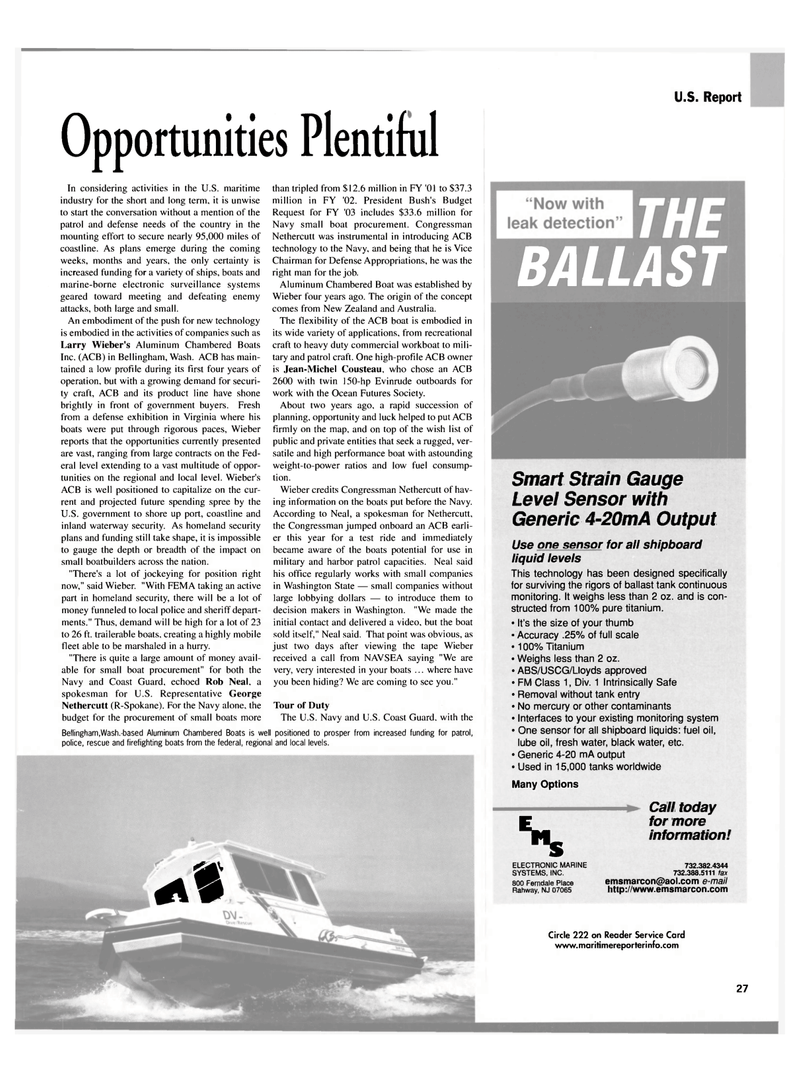
Page 29: of Maritime Reporter Magazine (August 2002)
Read this page in Pdf, Flash or Html5 edition of August 2002 Maritime Reporter Magazine
Opportunities Plentiful
U.S. Report
In considering activities in the U.S. maritime industry for the short and long term, it is unwise to start the conversation without a mention of the patrol and defense needs of the country in the mounting effort to secure nearly 95,000 miles of coastline. As plans emerge during the coming weeks, months and years, the only certainty is increased funding for a variety of ships, boats and marine-borne electronic surveillance systems geared toward meeting and defeating enemy attacks, both large and small.
An embodiment of the push for new technology is embodied in the activities of companies such as
Larry Wieber's Aluminum Chambered Boats
Inc. (ACB) in Bellingham, Wash. ACB has main- tained a low profile during its first four years of operation, but with a growing demand for securi- ty craft, ACB and its product line have shone brightly in front of government buyers. Fresh from a defense exhibition in Virginia where his boats were put through rigorous paces, Wieber reports that the opportunities currently presented are vast, ranging from large contracts on the Fed- eral level extending to a vast multitude of oppor- tunities on the regional and local level. Wieber's
ACB is well positioned to capitalize on the cur- rent and projected future spending spree by the
U.S. government to shore up port, coastline and inland waterway security. As homeland security plans and funding still take shape, it is impossible to gauge the depth or breadth of the impact on small boatbuilders across the nation. "There's a lot of jockeying for position right now," said Wieber. "With FEM A taking an active part in homeland security, there will be a lot of money funneled to local police and sheriff depart- ments." Thus, demand will be high for a lot of 23 to 26 ft. trailerable boats, creating a highly mobile fleet able to be marshaled in a hurry. "There is quite a large amount of money avail- able for small boat procurement" for both the
Navy and Coast Guard, echoed Rob Neal, a spokesman for U.S. Representative George
Nethercutt (R-Spokane). For the Navy alone, the budget for the procurement of small boats more
Bellingham,Wash.-based Aluminum Chambered Boats is well positioned to prosper from increased funding for patrol, police, rescue and firefighting boats from the federal, regional and local levels. than tripled from $12.6 million in FY '01 to $37.3 million in FY '02. President Bush's Budget
Request for FY '03 includes $33.6 million for
Navy small boat procurement. Congressman
Nethercutt was instrumental in introducing ACB technology to the Navy, and being that he is Vice
Chairman for Defense Appropriations, he was the right man for the job.
Aluminum Chambered Boat was established by
Wieber four years ago. The origin of the concept comes from New Zealand and Australia.
The flexibility of the ACB boat is embodied in its wide variety of applications, from recreational craft to heavy duty commercial workboat to mili- tary and patrol craft. One high-profile ACB owner is Jean-Michel Cousteau, who chose an ACB 2600 with twin 150-hp Evinrude outboards for work with the Ocean Futures Society.
About two years ago, a rapid succession of planning, opportunity and luck helped to put ACB firmly on the map, and on top of the wish list of public and private entities that seek a rugged, ver- satile and high performance boat with astounding weight-to-power ratios and low fuel consump- tion.
Wieber credits Congressman Nethercutt of hav- ing information on the boats put before the Navy.
According to Neal, a spokesman for Nethercutt, the Congressman jumped onboard an ACB earli- er this year for a test ride and immediately became aware of the boats potential for use in military and harbor patrol capacities. Neal said his office regularly works with small companies in Washington State — small companies without large lobbying dollars — to introduce them to decision makers in Washington. "We made the initial contact and delivered a video, but the boat sold itself," Neal said. That point was obvious, as just two days after viewing the tape Wieber received a call from NAVSEA saying "We are very, very interested in your boats ... where have you been hiding? We are coming to see you."
Tour of Duty
The U.S. Navy and U.S. Coast Guard, with the
A*
BALLAST
Smart Strain Gauge
Level Sensor with
Generic 4~20mA Output
Use one sensor for all shipboard liquid levels
This technology has been designed specifically for surviving the rigors of ballast tank continuous monitoring. It weighs less than 2 oz. and is con- structed from 100% pure titanium. • It's the size of your thumb • Accuracy .25% of full scale • 100% Titanium • Weighs less than 2 oz. • ABS/USCG/Lloyds approved • FM Class 1, Div. 1 Intrinsically Safe • Removal without tank entry • No mercury or other contaminants • Interfaces to your existing monitoring system • One sensor for all shipboard liquids: fuel oil, lube oil, fresh water, black water, etc. • Generic 4-20 mA output • Used in 15,000 tanks worldwide
Many Options s
ELECTRONIC MARINE
SYSTEMS, INC. 800 Ferndaie Place
Rahway, NJ 07065
Call today for more information! 732.382.4344 732.388.5111 lax [email protected] e-mail http://www.emsmarcon.com
Circle 222 on Reader Service Card www.maritimereporterinfo.com 27

 28
28

 30
30
